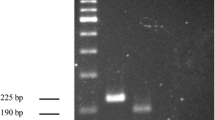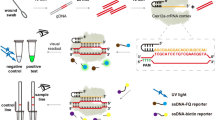Abstract
The increasing threat of Streptococcus gallolyticus subsp. gallolyticus (SGG) infections has gained considerable attention for its strong association with colorectal cancer (CRC). Herein, we proposed real-time fluorescence loop-mediated isothermal amplification (LAMP) as a novel, simple, rapid, and highly sensitive assay for identifying SGG for the first time. This assay was capable of detecting SGG with initial DNA concentrations ranging from 102 to 108 copies per microliter, under isothermal conditions within 30 min via real-time fluorescence monitoring. Our method was tested for specific identification of SGG strains without cross-reaction with other Streptococcus gallolyticus subspecies and Escherichia coli. The developed LAMP shows a superior performance with shorter time and higher sensitivity compared with conventional polymerase chain reaction (PCR). Significantly, this proposed approach was successfully applied for detecting SGG in clinical urine samples, which is non-invasive diagnosis, showing excellent accuracy and reliability to discriminate healthy controls and CRC patients. For comparison, these samples were also tested against PCR assay. These results yielded an analytical sensitivity of 100% and a specificity of 100% for SGG testing using LAMP. The findings suggest LAMP can be employed for detecting SGG infections which is useful for diagnosis and screening of CRC.







Similar content being viewed by others
References
Bray F, Ferlay J, Soerjomataram I, Siegel RL, Torre LA, Jemal A. Global cancer statistics 2018: GLOBOCAN estimates of incidence and mortality worldwide for 36 cancers in 185 countries. CA Cancer J Clin. 2018;68(6):394–424.
Sears CL, Garrett WS. Microbes, microbiota, and colon cancer. Cell Host Microbe. 2014;15(3):317–28.
Louis P, Hold GL, Flint HJ. The gut microbiota, bacterial metabolites and colorectal cancer. Nat Rev Microbiol. 2014;12(10):661–72.
Pasquereau-Kotula E, Martins M, Aymeric L, Dramsi S. Significance of Streptococcus gallolyticus subsp. gallolyticus Association With Colorectal Cancer. Front Microbiol. 2018;9:614.
Boleij A, Tjalsma H. Gut bacteria in health and disease: a survey on the interface between intestinal microbiology and colorectal cancer. Biol Rev Camb Philos Soc. 2012;87(3):701–30.
Abdulamir AS, Hafidh RR, Bakar FA. Molecular detection, quantification, and isolation of Streptococcus gallolyticus bacteria colonizing colorectal tumors: inflammation-driven potential of carcinogenesis via IL-1, COX-2, and IL-8. Mol Cancer. 2010;9(1):249.
Boleij A, Muytjens CM, Bukhari SI, Cayet N, Glaser P, Hermans PW, et al. Novel clues on the specific association of Streptococcus gallolyticus subsp gallolyticus with colorectal cancer. J Infect Dis. 2011;203(8):1101–9.
Boleij A, van Gelder MM, Swinkels DW, Tjalsma H. Clinical importance of Streptococcus gallolyticus infection among colorectal cancer patients: systematic review and meta-analysis. Clin Infect Dis. 2011;53(9):870–8.
Boleij A, Roelofs R, Danne C, Bellais S, Dramsi S, Kato I, et al. Selective antibody response to Streptococcus gallolyticus pilus proteins in colorectal cancer patients. Cancer Prev Res (Phila). 2012;5(2):260–5.
Butt J, Romero-Hernandez B, Perez-Gomez B, Willhauck-Fleckenstein M, Holzinger D, Martin V, et al. Association of Streptococcus gallolyticus subspecies gallolyticus with colorectal cancer: serological evidence. Int J Cancer. 2016;138(7):1670–9.
Butt J, Werner S, Willhauck-Fleckenstein M, Michel A, Waterboer T, Zornig I, et al. Serology of Streptococcus gallolyticus subspecies gallolyticus and its association with colorectal cancer and precursors. Int J Cancer. 2017;141(5):897–904.
Butt J, Jenab M, Willhauck-Fleckenstein M, Michel A, Pawlita M, Kyro C, et al. Prospective evaluation of antibody response to Streptococcus gallolyticus and risk of colorectal cancer. Int J Cancer. 2018;143(2):245–52.
Kumar R, Herold JL, Schady D, Davis J, Kopetz S, Martinez-Moczygemba M, et al. Streptococcus gallolyticus subsp. gallolyticus promotes colorectal tumor development. PLoS Pathog. 2017;13(7):e1006440.
Abdulamir AS, Hafidh RR, Mahdi LK, Al-jeboori T, Abubaker F. Investigation into the controversial association of Streptococcus gallolyticus with colorectal cancer and adenoma. BMC Cancer. 2009;9:403.
Corredoira-Sánchez J, García-Garrote F, Rabuñal R, López-Roses L, García-País MJ, Castro E, et al. Association between bacteremia due to Streptococcus gallolyticus subsp. gallolyticus (Streptococcus bovis I) and colorectal neoplasia: a case-control study. Clin Infect Dis. 2012;55(4):491–6.
Farooq U, Yang Q, Ullah MW, Wang S. Bacterial biosensing: recent advances in phage-based bioassays and biosensors. Biosens Bioelectron. 2018;118:204–16.
Nadkarni MA, Martin FE, Jacques NA, Hunter N. Determination of bacterial load by real-time PCR using a broad-range (universal) probe and primers set. Microbiology. 2002;148(1):257–66.
Zhao Y, Chen F, Li Q, Wang L, Fan C. Isothermal amplification of nucleic acids. Chem Rev. 2015;115(22):12491–545.
Reid MS, Le XC, Zhang H. Exponential isothermal amplification of nucleic acids and assays for proteins, cells, small molecules, and enzyme activities: an EXPAR example. Angew Chem Int Ed. 2018;57(37):11856–66.
Notomi T, Mori Y, Tomita N, Kanda H. Loop-mediated isothermal amplification (LAMP): principle, features, and future prospects. J Microbiol. 2015;53(1):1–5.
Notomi T, Okayama H, Masubuchi H, Yonekawa T, Watanabe K, Amino N, et al. Loop-mediated isothermal amplification of DNA. Nucleic Acids Res. 2000;28(12):e63.
Ganguli A, Ornob A, Spegazzini N, Liu Y, Damhorst G, Ghonge T, et al. Pixelated spatial gene expression analysis from tissue. Nat Commun. 2018;9(1):202.
Zhao Y, Chen F, Qin J, Wei J, Wu W, Zhao Y. Engineered Janus probes modulate nucleic acid amplification to expand the dynamic range for direct detection of viral genomes in one microliter crude serum samples. Chem Sci. 2018;9(2):392–7.
Yu J, Wang F, Zhan X, Wang X, Zuo F, Wei Y, et al. Improvement and evaluation of loop-mediated isothermal amplification combined with a chromatographic flow dipstick assay and utilization in detection of Vibrio cholerae. Anal Bioanal Chem. 2019;411(3):647–58.
Loo JF, But GW, Kwok HC, Lau PM, Kong SK, Ho HP, et al. A rapid sample-to-answer analytical detection of genetically modified papaya using loop-mediated isothermal amplification assay on lab-on-a-disc for field use. Food Chem. 2019;274:822–30.
Zahradnik C, Martzy R, Mach RL, Krska R, Farnleitner AH, Brunner K. Detection of the food allergen celery via loop-mediated isothermal amplification technique. Anal Bioanal Chem. 2014;406(27):6827–33.
Wang H, Ma Z, Qin J, Shen Z, Liu Q, Chen X, et al. A versatile loop-mediated isothermal amplification microchip platform for Streptococcus pneumoniae and Mycoplasma pneumoniae testing at the point of care. Biosens Bioelectron. 2019;126:373–80.
Zhang L, Tian F, Liu C, Feng Q, Ma T, Zhao Z, et al. Hand-powered centrifugal microfluidic platform inspired by the spinning top for sample-to-answer diagnostics of nucleic acids. Lab Chip. 2018;18(4):610–9.
Phillips EA, Moehling TJ, Bhadra S, Ellington AD, Linnes JC. Strand displacement probes combined with isothermal nucleic acid amplification for instrument-free detection from complex samples. Anal Chem. 2018;90(11):6580–6.
Du Y, Pothukuchy A, Gollihar JD, Nourani A, Li B, Ellington AD. Coupling sensitive nucleic acid amplification with commercial pregnancy test strips. Angew Chem Int Ed. 2017;56(4):992–6.
Tomita N, Mori Y, Kanda H, Notomi T. Loop-mediated isothermal amplification (LAMP) of gene sequences and simple visual detection of products. Nat Protoc. 2008;3(5):877–82.
Lopes PG, Cantarelli VV, Agnes G, Costabeber AM, d'Azevedo PA. Novel real-time PCR assays using TaqMan minor groove binder probes for identification of fecal carriage of Streptococcus bovis/Streptococcus equinus complex from rectal swab specimens. J Clin Microbiol. 2014;52(3):974–6.
Hatrongjit R, Akeda Y, Hamada S, Gottschalk M, Kerdsin A. Multiplex PCR for identification of six clinically relevant streptococci. J Med Microbiol. 2017;66(11):1590–5.
Cao G, Kong J, Xing Z, Tang Y, Zhang X, Xu X, et al. Rapid detection of CALR type 1 and type 2 mutations using PNA-LNA clamping loop-mediated isothermal amplification on a CD-like microfluidic chip. Anal Chim Acta. 2018;1024:123–35.
Dong J, Xu Q, Li CC, Zhang CY. Single-color multiplexing by the integration of high-resolution melting pattern recognition with loop-mediated isothermal amplification. Chem Commun. 2019;55(17):2457–60.
Jans C, Meile L, Lacroix C, Stevens MJ. Genomics, evolution, and molecular epidemiology of the Streptococcus bovis/Streptococcus equinus complex (SBSEC). Infect Genet Evol. 2015;33:419–36.
Schlegel L, Grimont F, Ageron E, Grimont PA, Bouvet A. Reappraisal of the taxonomy of the Streptococcus bovis/Streptococcus equinus complex and related species: description of Streptococcus gallolyticus subsp. gallolyticus subsp. nov., S. gallolyticus subsp. macedonicus subsp. nov. and S. gallolyticus subsp. pasteurianus subsp. nov. Int J Syst Evol Microbiol. 2003;53(3):631–45.
Chen J, Xu Y, Yan H, Zhu Y, Wang L, Zhang Y, et al. Sensitive and rapid detection of pathogenic bacteria from urine samples using multiplex recombinase polymerase amplification. Lab Chip. 2018;18(16):2441–52.
Li C, Li Z, Jia H, Yan J. One-step ultrasensitive detection of microRNAs with loop-mediated isothermal amplification (LAMP). Chem Commun. 2011;47(9):2595–7.
Acknowledgments
The authors gratefully acknowledge the Department of Clinical Laboratory, Yangpu Hospital (Shanghai, China), for the help in collecting clinical urine samples.
Funding
This work was funded by the National Natural Science Foundation of China (21375027, 21335002, 21427806), Shanghai Pujiang Program (17PJD001, 18PJD047), and Natural Science Foundation of Shanghai (12ZR1401700, 17JC1400100).
Author information
Authors and Affiliations
Corresponding authors
Ethics declarations
All participants in this study provided written informed consent prior to testing. The study design was approved by the institutional research commission of Fudan University (Shanghai, China). Ethical approval was obtained from the Ethics Committee of the Department of Clinical Laboratory, Yangpu Hospital (Shanghai, China).
Conflict of interest
The authors declare that they have no conflicts of interest.
Additional information
Publisher’s note
Springer Nature remains neutral with regard to jurisdictional claims in published maps and institutional affiliations.
Electronic supplementary material
ESM 1
(PDF 76 kb)
Rights and permissions
About this article
Cite this article
Lin, Q., Ye, X., Yang, B. et al. Real-time fluorescence loop-mediated isothermal amplification assay for rapid and sensitive detection of Streptococcus gallolyticus subsp. gallolyticus associated with colorectal cancer. Anal Bioanal Chem 411, 6877–6887 (2019). https://doi.org/10.1007/s00216-019-02059-8
Received:
Revised:
Accepted:
Published:
Issue Date:
DOI: https://doi.org/10.1007/s00216-019-02059-8




